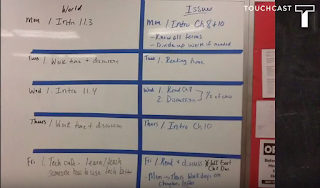This school year, however, I have found my inner artist. I have been using Doceri for years to control my computer wirelessly, add content to my lessons on the fly, and make custom presentations and "My Recordings" to flip classroom content. Over a year ago, my friend and colleague, Jason Bretzmann, gave me a 53 Pencil stylus as a gift. Jason knew I appreciate a quality writing utensil, and was looking for a better stylus for my iPad. This is where the 53 Pencil helped me to further develop my artistic skills. There was only one problem.....the 53 Pencil did not work with my iPad2. The 53 Pencil sat in its box until this school year, when my school bought me an iPad Air 2.
If you have been using Doceri or have viewed the tutorial videos, you see the powerful abilities Doceri has in the hands of skillful artists. While I am not a skillful artist, I always want to push myself and find ways to grow and improve as a professional. With my iPad Air 2, my 53 Pencil and Doceri, I have been able to stop drawing squares....most of the time.
I moderate a Twitter chat every Tuesday night, 8PM CST, called #personalizedPD. In the chat we focus on the book that I co-authored, "Personalized PD: Flipping Your Professional Development."
I was looking for a visual to help promote the ideas I discuss in my chapter: the ABCCs of PersonalizedPD: Attendance, Balance, Choice, Communication. I had a few ideas in mind, when I decided I wanted to use a soup can. I used my iPad and found an image online. I then took the image and pasted it into the background of a Doceri project. Next, I used my 53 Pencil and began to remove the images and text I didn't want in order to create my custom look.
I used the image from my book above and placed it in the center of the can, adding a black circle to help focus the eye on the book. After I added more text to the can, I cropped out the rest of the iPad screen and saved the picture to my camera roll. From there, I uploaded the final picture of a promotional image for my book via my Twitter account.
Final picture upload to Twitter
I continued to experiment with using Doceri to make custom artwork to promote my work. I teach graduate classes and one of our offerings is called Patio PD (Professional Development). During Patio PD, teachers meet at an educator's house and discuss various topics and ideas they would like to implement in their classrooms. Our biggest Patio PD event is coming up on July 14th, International #PatioPD day. To help promote this day I used a famous WWI propaganda poster and made some adjustments.
The boy in the foreground is playing with army/military toys meaning that even he, a young boy likes war and wants to be a part of it. The daughter is on her father's lap with her history book asking about WWI and what he did during this historic event. The father's face shows concern because he did not fight in the war and doesn't know what to say. The point being that each of us should do something during WWI so we can hold our heads high in the future. I took this poster and made artistic adjustments to fit my needs.
I used the ability of Doceri to add layers of pictures and then easily draw over them to replace the toy soldiers on the ground with a patio. I took our International #PatioPD sign and added it close to his head so that is appears his is thinking about it. I used the same general question that was asked but I changed the premise to be about our International #PatioPD day.
As I worked on both projects, I learned the valuable lesson of zooming in on an image when coloring it within Doceri. At first, I was trying to color in images from the standard viewing distance and struggled to accurately remove the sections I desired. After zooming in I was able to correct fine details much more easily.
Recently, my students have been interested in Tykes and trying to create their own custom Tyke. Once again, Doceri and the customization art options made this simple. I found some Tykes online and built a character that looks close to my teacher image. I was able to use Doceri's features and color over and add other aspects to the Tyke to make it look more like me. I found the images I needed: a basketball court, a ball, a business suit person, and a head that was similar to mine, and I was set.
I placed the images into a Doceri project and then used the 53 Pencil to color over the images I wanted to remove and cut. Then I layered the other images on top. I zoomed in on the head while working in Doceri to change the hair and eye color to better match my own.
I added my own signature and then I took a screen shot of the work on my iPad, cropped the image and finalized my work.
While I am not an artist, and my work is far from perfect, I have found a way to use Doceri's artistic capabilities to strengthen an area of weakness.


























